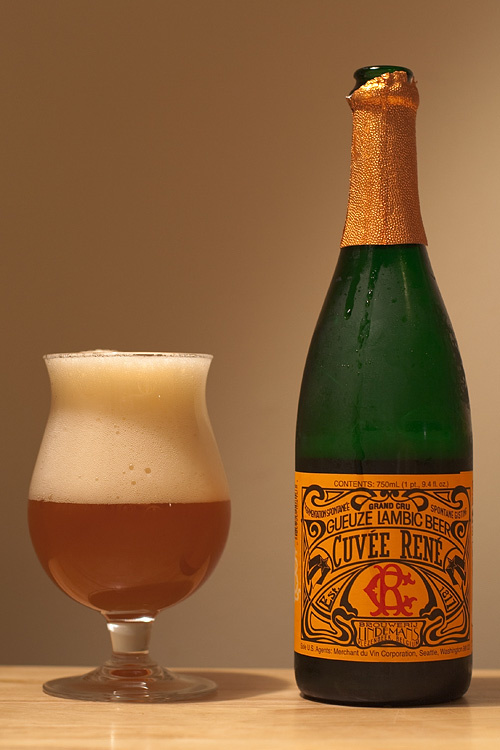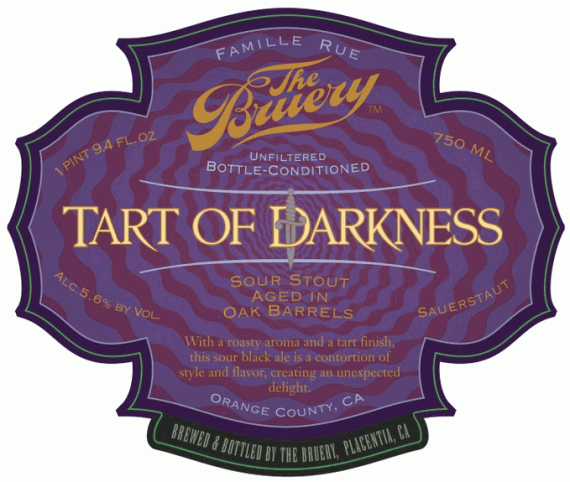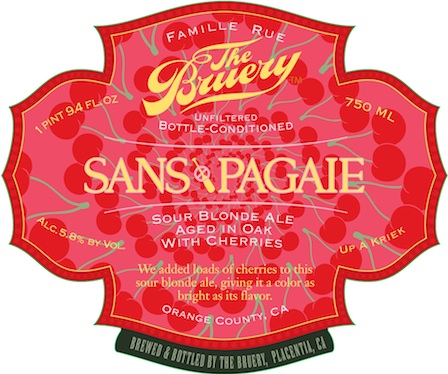-by Matt Strickland, The Bruery's Wood Cellarman
I wrote this piece about 8 months ago for another website I was
writing for at the time (www.grogsociety.com). Since we have a Sour
Beer class coming up at The Bruery Provisions on August 13th
(Stop by or email Provisions for more details) I thought this would
be a good time to resurrect it for The Bruery blog. Of course you
could also be cynical about the damn thing and call me lazy for
rehashing stuff. You would also be right…and not my favorite
person.
The
Power of Sour: The Emergence of Modern Sour Beers
When
I was 11 or 12 I considered myself a candy connoisseur. My appetite
for those treats in the grocery-checkout lane was rarely sated.
Always on the hunt for the next great sugar high, I found in my hand
one day a bag of Warheads. (For the uninitiated, Warheads were
superlatively sour bite-sized pieces of tooth torture.) I popped the
first one into my mouth. My lips puckered and my tongue began to
drown in cleansing saliva. I was hooked. From that day forward, I
sought only the sourest of sour candies: lemon drops, candy straws,
and gumballs that seemed to resemble miniature Death-Stars made
solely of citric acid. I couldn’t get enough of that teeth-rotting
goodness, but it was never sour enough. My friends and I searched
relentlessly for something that would take tartness to the next
level. We wanted pleasure and pain, the pre-adolescent equivalent to
the type of jack-assery that ensues when you combine a nose, a straw,
and wasabi.
My wife may dispute
this point, but I am an adult now. My candy intake is strictly
monitored. The sour candy indiscretions of my youth are long behind
me. “Sellout!”, you say? No, I’ve just found new ways to get
my fix. Sour candy youth transplants often veer towards the
hot-sauce craze when they grow older, and I can certainly count
myself amongst the capsaicin acolytes, but the object of my youthful
obsession has been reincarnated in Belgian-style sour beers. Belgian
lambics, Flanders reds and browns, and now a number of American
breweries have thrown their barrels into that ring. It’s a great
time to be a sour beer lover.
That First Taste

I encountered my
first true sour ale about 7 years ago on trip to Chicago. I was a
few years into my switch from big-brew swiller to microbrew maven
when I came across a bottle of Lindeman’s Gueuze Cuvée René. I
had heard of said beer through various outlets, and most of the
reviews had been complimentary though a bit esoteric. The common
aroma descriptors at the time were “barnyard”, “horse blanket”,
and “sweat”, usually followed by acclaim and elitist caveats to
the effect of “Not for the faint of heart.” Well, brew-love
bravado brought out my wallet and I purchased the bottle for
consumption later that night. I popped the cork with an air of
sophistication and poured glasses for my two friends. We smelled.
We sipped. They spit. I choked it down fast enough to feign an
appreciative grin. It was one of those moments when I thought, “I
should like this, but I
don’t.” Further research
led me to the conclusion that, like brussels sprouts, sour beer was
an acquired taste. This concerned me. Despite my parents’ best
intentions and dinner table ruses, I still can’t stand sprouts of
any kind. All the same, I was determined to understand what the sour
ale hubbub was about.
Fast-forward a few
years. I was in Belgium on vacation with some friends, spending a
few days in Antwerp. My knowledge of all things beery had led us to
a hidden gem of a pub called The Kulminator. We sat down in the back
patio encircled by crumbling stone walls and about a dozen stray
cats. Our server was an affable old Flemish woman who spoke very
little English. She quietly brought out the beer menu, a compendium
of more than 500 beers, mostly Belgian and nearly half vintage-dated.
Like any good beer geek, I had done my homework. I promptly went
for Boon’s Framboise, a 3-year-old bottle of Belgian lambic sour
beer aged with raspberries. Some minutes later, my anticipation was
rewarded with a dusty bottle laid down in a small wicker basket. Our
server poured us all a glass. I felt a thrill of trepidation.
“Here we go again,” I thought. “Once more into the breach.”
And there it was: the sight, the smell, and then the taste.
Euphoria in my mouth and eureka in my mind, that bottle of lambic
became a revelation. The aroma was laden with earthy notes, lactic
sourness, and red fruit tones. The taste was light and lactic with a
spritzy carbonation that cleansed a palate clamoring for more. I had
found a new obsession.
Make no
mistake—these beers are complex. Indeed, if you’ve been
searching for a beer to put your faculties of smell and taste through
a sensory decathlon, look no further. Depending on the sub-style you
imbibe, you may encounter smells of raisins, dark fruit, apples, hay,
horse blanket, honey, cherries, plums, raspberries, vanilla, cedar
and more, all encased in a firm lactic sourness that can be subdued
or brazen. Put the glass to your lips and tip it back. Those aromas
become flavors coupled with perhaps a little caramel, toffee,
maltiness, or citrus. Hopheads should check the lupulin madness at
the door. With few exceptions, hop aroma and bitterness are
virtually nonexistent in these beers. The acidity gives the balance
that the hops would otherwise provide. These tend to be very
refreshing beers, though some modern interpretations are a bit
heavier. Most commercial examples are of moderate strength, and
rarely will you see a sour ale go beyond 8% abv, though I’ve seen a
number of newer beers in stronger territory.
Bugs in my beer…
Even
if you’ve never tried sour ales, you’ve probably seen them.
These curiosities on the shop shelves and bottle bars, their labels
bearing strange names and unfamiliar words, are often passed over due
to their seemingly odd nature and the high price tag so many of them
command. Why are sour ales so bizarre, and why should you be willing
to fork over your hard-earned scratch for them? It’s all in how
they’re made.

When food goes
sour, we usually consider it spoiled. The sour sensation we
experience is caused by the presence of acids in the food. There are
numerous common food acids, and they produce varying levels of
perceived sourness on the palate. In fruits like apples and oranges
(See? You can compare them), these acids are naturally
present. In beer however, (putting aside the use of CO2
which forms carbonic acid and carbonation) the source of the
sensorially important acids is often microbial. Beer yeast will
produce varying amounts of lactic acid, but most strains that brewers
use have been bred to keep these flavors in check.
Modern sour beer
production takes a different approach. The brewers want those
acids, and they use a number of microbes to get them. The three big
“bugs,” as they are often called, that tend to get used in
addition to standard brewer’s yeasts are Brettanomyces (a yeast),
Lactobacillus, and Pediococcus (both are bacteria). American sour
beer producers will often choose one or a combination of these
critters to get the correct profile, while more “traditional”
producers in Belgium often utilize all of them and a whole lot more.
(Some producers will forgo the addition of microbes in favor of
simply adding straight lactic acid, though in my opinion this yields
inferior results.)
Most of these beers
start out as normal, easy drinking brews. Mix some grains with water
and lightly hop it. Brewer’s yeast gets pitched, and within a week
or two you’ve got yourself a beer. It is during the steps taken
after alcoholic fermentation when these beers are transformed.
Methods vary from region to region and brewer to brewer, but they all
include letting an “infection” take hold in the beer.
Lactic
acid bacteria such as Lactobacillus and Pediococcus move into the
beer either through addition by the brewer or because they’ve been
hanging out in the brewery all along. Either way, they set up shop
and multiply. These guys produce the bulk of lactic acid found in
sour ales. But if lactic acid was the only thing these bacteria
could produce then these beers probably wouldn’t have too much to
offer outside of making your mouth pucker a bit. For instance,
strains of lactobacillus can produce certain compounds called
tetrahydropyridines that are reminiscent of popcorn or white bread,
and in extreme cases yield what is called “mousy taint”.
Pediococcus can also produce a number of aroma compounds, though many
of these haven’t been researched heavily in beer.
Of all the microbes
found in beer and wine, Brettanomyces is certainly the most
controversial. Feared by brewers and winemakers all over the world,
it has found a circle of friends in those who love sour beers. The
reasons for Brett’s notoriety lie in its behavior. You see, Brett
is a survivor—you might even call it the Green Beret of the brewing
yeast world. It can survive for long periods on very little food,
even subsisting on wood sugars from barrels if nourishment gets
tight. And as soon as Brett walks into your brewery, he kicks his
feet up on the coffee table, and turns on that 24 hour “I Love
Lucy” marathon you secretly want to watch. In other words, you’re
not likely to get him to leave very easily. Once Brett gets around
beer, like so many of us, he becomes an animal, grabbing all he can.
Even though the brewer’s yeast should have eaten most of the beer
sugars already, Brett is more than happy to hang around and pick up
the scraps and can even ferment the sugars that brewer’s yeast
can’t, such as dextrins (this is partly why sour ales are often so
dry). On top of consuming sugar, Brettanomyces is famous for getting
nourishment from a dozen other sources, usually forming some pretty
interesting aroma compounds in the process. Ever hear someone
describe an aroma of bandaids in beer? That’s Brett. Ever had a
beer that had a subtle smoky flavor and yet no smoked malt was used?
It could be Brett. Goat, barnyard, antiseptic, and rubber can also
come from this yeast. On paper, none of this probably sounds
particularly appealing, but in a glass the story is a whole lot
better. These aromas are usually produced in fairly small amounts
and can blend together into a medley that is exciting and
otherworldly.
There are a couple
of drawbacks to adding all of this microflora to the beer. One is
that the flavors these microbes produce often take a lot of time to
develop. It is not uncommon to hear of these beers sitting in
barrels for months or even years before they ever see a bottle.
Another issue brewers must contend with is that the flavors can
sometimes run amuck, resulting in beers that are less than balanced
and sometimes completely ruined. For instance, lactic acid bacteria
can produce a fair amount of diacetyl (smells a lot like movie
theatre buttered popcorn) when the beer is young, though this is
considered a fault in most styles and time is needed for the compound
to be metabolized into less aromatic compounds like acetoin or
2,3-butanediol before the beer should be served. If the wrong strain
of Brett is used or if conditions allow it to get out of control, the
beer could wind up smelling like the bandage aisle of the drug store.
As Peter Bouckaert of New Belgium Brewing was quoted as saying, “If
you want to be good, you’re going to have to dump some beer.”
So go buy a
bottle already…
Selling
people on sour beers can be a tricky endeavor. These beers usually
do not resemble what most people consider “true” beer. Their
flavors are pronounced and the price of admission can be steep at
times. (Some bottles fetch prices of $30+, but most examples can be
had for $20 or less.) But for those with an adventurous spirit, they
can be revelatory beverages worthy of your time and money. And as
with most great adventures, these brews are best shared with friends
and food. Pour yourself a glass and you’ll see what I’m talking
about.
The
following is a list of recommended brews with general tasting notes.
Due to the nature of these beers, production is often small and you
may not be able to find some of them in your area. Ask around. The
world of sour ales is getting bigger all the time, and as much as I’d
like to, there’s just not enough room here to list all the great
ones. Cheers.
Sans Pagiae (The
Bruery; 5.8% abv)
We make quite a
number of sour ales here at The Bruery, however this one is currently
one of my favorites. This is our version of a Belgian-style Kriek.
It’s perfectly funky with a pleasing sourness and expressive cherry
flavors. Find a bottle fast before they’re all gone.
Temptation
(Russian River Brewing; 7.25% abv)
Vinnie Cilurzo has
been at the forefront of the American wild ale scene for several
years now with his line of barrel aged beauties. Temptation is a
Belgian style blonde aged for 12 months in Chardonnay barrels with
Brettanomyces. This beer showcases a lovely tartness with plenty of
oak and fruit to back it up.
Kriek (Brouwerij
Cantillon; 5% abv)
Cantillon is one of
the most prominent producers of traditional lambic beers coming out
of Belgium. Hunt down anything with their name on the bottle, but
this one in particular is a real treasure. Earthy, musty, and sour
wrap around subtle cherry and red fruit flavors. This is the real
deal.
Rodenbach Grand
Cru (Brouwerij Rodenbach; 6%abv)
Sour ale lovers
would hunt me down and drown me in a vat of Bud Lite if I didn’t
mention this beer. This is a great example of the Flanders Red style
from Belgium. Aged for nearly 2 years in oak tuns, this is a beer
designed for quiet contemplation. Tart cherry and vanilla give way
to a background of malty sweetness. Truly classic.
La Folie (New
Belgium Brewing; 6% abv)
New Belgium Brewing
was lucky enough to steal Peter Bouckaert away from Rodenbach several
years ago and it’s a good thing too. Bouckaert is a God in the
sour beer world of Odin like proportions, but this beer feels more of
a Loki-like effort for all its mischievousness. Sour apple, oak,
dark fruits and a hint of Brett: What’s not to love?
Kriek Ale
(Cascade Brewing; 7.3% abv)
For my money, these
guys are some of the most creative producers of American sour beers.
The logo on their T-shirts even reads “House of Sour” so you
know what you’re in for here. Their Kriek spends over 6 months in
oak with their own special strain of Lactobacillus. This is an
intensely sour beer with gorgeous cherry aromas and a hint of cherry
pie crust in the mouth.
 At one point in
time, porter was a barreled product. And as Bruery fans probably
know by now, Brettanomyces also like to go into barrels (they can
live off the wood sugars). Put the two together and you get one
Mutha’ Funky Porter. Read a few accounts by various brewing
historians and they will all attest to the existence of Brett-based
Porters. In other parts of the world, the Brett characters of clove,
smoke, and horse blanket were actually considered essential
components in British porter. Even a few years past World War II
there was still at least one German brewer who used Brett in his
“British Porter,” claiming that it was absolutely necessary to
get the style right.
At one point in
time, porter was a barreled product. And as Bruery fans probably
know by now, Brettanomyces also like to go into barrels (they can
live off the wood sugars). Put the two together and you get one
Mutha’ Funky Porter. Read a few accounts by various brewing
historians and they will all attest to the existence of Brett-based
Porters. In other parts of the world, the Brett characters of clove,
smoke, and horse blanket were actually considered essential
components in British porter. Even a few years past World War II
there was still at least one German brewer who used Brett in his
“British Porter,” claiming that it was absolutely necessary to
get the style right.














